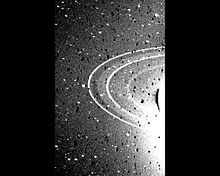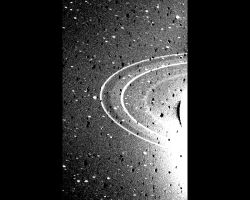Prstence Neptunu

Planeta Neptun má systém planetárních prstenců, které jsou známé jako Neptunovy prstence.
Existence prstenců okolo planety byla známa již od 60. let 20. století,[zdroj?] ale definitivní potvrzení jejich existence přinesla až sonda Voyager 2, která pomohla objevit 3 prstence okolo Neptunu. Jsou velmi nevýrazné a tenké a podobně jako u Jupiteru a Saturnu jsou značně tmavé. Jejich složení je neznámé.[1]
Nejvzdálenější a nejvýznamnější prstenec (pojmenovaný Adams) je zvláštní tím, že tvoří asi tři výraznější oblouky, poblíž kterých je nejvíc hmoty. Tato zhuštění mají i vlastní pojmenování: Volnost, Rovnost a Bratrství.[2] Po prstenci Adams následuje bezejmenný prstenec se stejnou oběžnou drahou jako má měsíc Galatea. Za ním je Leverrier s vnějším protažením v podobě Lassella a Araga a na nejblíže planetě se nachází tenký, ale široký prstenec Galle.[2]
Reference
- ↑ Neptune [online]. nineplanets.org [cit. 2008-12-28]. Dostupné online. (anglicky)
- ↑ a b WAGNER, Jiří. Sluneční soustava – Neptun [online]. [cit. 2008-12-27]. Dostupné v archivu pořízeném dne 2009-01-27.
Externí odkazy
 Obrázky, zvuky či videa k tématu Prstence Neptunu na Wikimedia Commons
Obrázky, zvuky či videa k tématu Prstence Neptunu na Wikimedia Commons
Média použitá na této stránce
This 591-second exposure of the rings of Neptune were taken with the clear filter by the Voyager 2 wide-angle camera. The two main rings are clearly visible and appear complete over the region imaged.
Also visible in this image is the inner faint ring and the faint band which extends smoothly from the ring roughly halfway between the two bright rings. Both of these newly discovered rings are broad and much fainter than the two narrow rings.
The bright glare is due to overexposure of the crescent on Neptune. Numerous bright stars are evident in the background. Both bright rings have material throughout their entire orbit, and are therefore continuous.